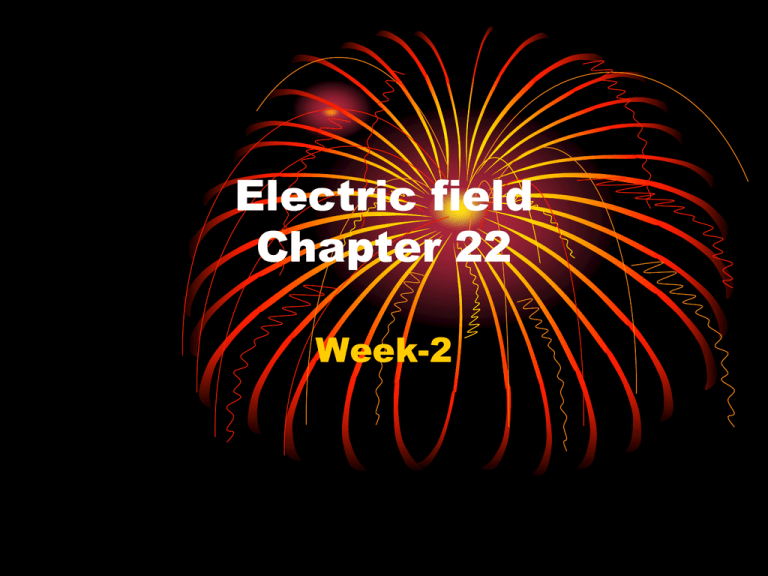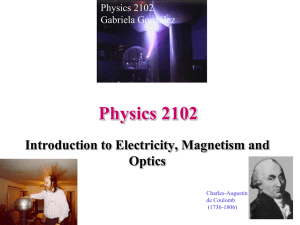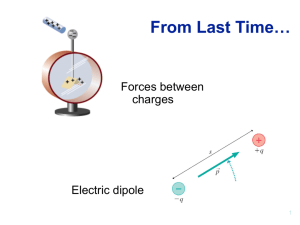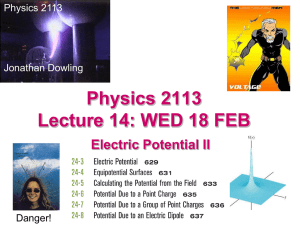Electric Fields
advertisement

Electric field Chapter 22 Week-2 Electric Fields (22-1) In this chapter we will introduce the concept of an electric field. As long as charges are stationary Coulomb’s law described adequately the forces among charges. If the charges are not stationary we must use an alternative approach by introducing the electric field (symbolE ). In connection with the electric field, the following topics will be covered: -Calculate the electric field generated by a point charge. -Using the principle of superposition determine the electric field created by a collection of point charges as well as continuous charge distributions. -Once the electric field at a point P is known we will be calculate the electric force on any charge placed at P -Define the notion of an “electric dipole”. Determine the net force , the net torque, exerted on an electric dipole by a uniform electric field, as well as the dipole potential energy. Fields Imagine an object is placed at a particular point in space. When placed there, the object experiences a force F. We may not know WHY there is a force on the object, although we usually will. Suppose further that if we double some property of the object (mass, charge, …) then the force is found to double as well. Then the object is said to be in a force field. The strength of the field (field strength) is defined as the ratio of the force to the property that we are dealing with. Electric Field If a charge Q is in an electric field E then it will experience a force F. The Electric Field is defined as the force per unit charge at the point. Electric fields are caused by charges and consequently we can use Coulombs law to calculate it. For multiple charges, add the fields as VECTORS. Two Charges F 1 qq0 q E k 2 runit k 2 runit q0 q0 r r Doing it Q A Charge r F q The spot where we want to know the Electric Field qQ F k runit 2 r F Q E k 2 runit q r GeneralqQ F k 2 runit r Q F k 2 runit E r q General E E j Fj q k Qj r 2 j r j ,unit Force Field E qoP r q Electric field generated by a point charge Consider the positive charge q shown in the figure. At point P a distance r from q we place the test charge qo . The force exerted on qo by qo is equal to: q qo F 4 o r 2 1 E F 1 q qo qo 4 o qo r 2 q 4 o r 2 1 The magnitude of E is a positive number E (22-4) 1 q 4 o r 2 In terms of direction, E points radially outwards as shown in then figure. If q were a negative charge the magnitude of E remains the same. The direction of E points radially inwards instead O O Electric field generated by a group of point charges. Superposition The net electric electric field E generated by a group of point charges is equal to the vector sum of the electric field vectors generated by each charge. In the example shown in the figure E E1 E2 E3 Here E1 , E2 , and E3 are the electric field vectors generated by q1 , q1 , and q3 , respectively Note: E1 , E2 , and E3 must be added as vectors Ex E1x E2 x E3 x , E y E1 y E2 y E3 y , Ez E1z E2 z E3 z (22-5) What is the electric field at the center of the square array? Electric Dipole A system of two equal charges of opposite sign (22-6) +q q placed at a distance d is known as an "electric dipole". For every electric dipole we associate d -q a vector known as "the electric dipole moment" (symbol p )defined as follows: +q/2 The magnitude p qd +q/2 The direction of p is along the line that connects the two charges and points from - q to q. Many molecules have a built-in electric dipole -q moment. An example is the water molecule (H 2 O) The bonding between the O atom and the two H atoms involves the sharing of 10 valence electrons (8 from O and 1 from each H atom) Electric field generated by an electric dipole We will determine the electric field E generated by the electric dipole shown in the figure using the principle of superposition. The positive charge generates at P an electric 1 q field whose magnitude E( ) The negative charge 2 4 o r creates an electric field with magnitude E( ) 1 q 4 o r2 The net electric field at P is: E E( ) E( ) 1 q q 1 q q E 2 2 2 2 4 o r r 4 o z d / 2 z d / 2 2 2 d d d E 1 1 We assume: << 1 2 4 o z 2 z 2z 2 z q d d qd 1 p E 1 1 = 2 3 4 o z z z 2 o z 2 o z 3 q 1 x 2 (22-7) = 1 2x Kinds of continuously distributed charges Line of charge l = the charge per unit length. dq= lds (ds= differential of length along the line) Area s = charge per unit area dq=sdA dA = dxdy (rectangular coordinates) dA= 2rdr for elemental ring of charge Volume r=charge per unit volume dq=rdV dV=dxdydz or 4r2dr or some other expressions we will look at later. Continuous Charge Distribution Symmetry Let’s Do it Real Time Concept – Charge per unit length l dq= l ds The math ds rd Ey 0 Why? 0 dq E x (2) k 2 cos( ) r 0 0 E x (2) k 0 0 lrd r 2 cos( ) 2k 2k Ex l cos( )d l sin( 0 ) r 0 r Example : Detemine the electric field E generated at point P by a uniformly charged ring of radius R and total charge q. Point P lies on the normal to the ring plane that passes through the ring center C, at a distance z. Consider the charge element of length dS and charge dq shown in the firgure. The distance between the element and point P is r z 2 R 2 The charge dq generates at P an electric field of magnitude dE and which points outwards along the line AP. dq dE The z-component of dE is given by: 2 4 o r C A dq (22-9) dEz dE cos From triangle PACwe have: cos z / r dEz Ez zdq zdq 4 o r 3 4 z 2 R 2 3/ 2 o z 4 o z R 2 2 3/ 2 dq Ez dEz zq 4 o z R 2 2 3/ 2 The Geometry (the disk) Define surface charge density s=charge/unit-area (z2+r2)1/2 dq=sdA dA=2rdr dq=s dA = 2srdr (z2+r2)1/2 dq cos( ) k 2rsdr z dE z k 2 2 2 2 z r z r z2 r2 R E z 2ksz 0 z rdr 2 r 2 3/ 2 1/ 2 Final Result (z2+r2)1/2 s z 1 E z 2 2 2 z R 0 When R , s Ez 2 0 3. Electric field lines extend away from positive charges (where they originate) and towards negative charges (where they terminate) Example 1 : Electric field lines of a negative point charge - q E 1 q 4 o r 2 q -The electric field lines point towards the point charge -The direction of the lines gives the direction of E -The density of the lines/unit area increases as the distance from q decreases. Note : In the case of a positive point charge the electric field lines have the same form but they point outwards q (22-11) Example 3. Electric field lines generated by an electric dipole (a positive and a negative point charge of the same size but of opposite sign) Example 4. Electric field lines generated by two equal positive point charges (22-13) Look at the “Field Lines” F+ Forces and torques exerted on electric dipoles by a uniform electric field Consider the electric dipole shown in the figure in the presence of a uniform (constant magnitude and direction) electric field E along the x-axis The electric field exerts a force F qE on the F- x-axis positive charge and a force F qE on the negatice charge. The net force on the dipole Fnet qE qE 0 The net torque generated by F and F about the dipole center is: d d sin F sin qEd sin pE sin 2 2 In vector form: p E The electric dipole in a uniform electric field does not move F but can rotate about its center F 0 net p E (22-14) Potential energy of an electric dipole in a uniform electric field 90 90 U d pE sin d U pE sin d pE cos p E U pE cos 90 U pE p At point A ( 0) U has a minimum value U min pE B U 180˚ A (22-15) E It is a position of stable equilibrium At point B ( 180) U has a maximum value U max pE It is a position of unstable equilibrium p E p i Fig.a Work done by an external agent to rotate an electric E dipole in a uniform electric field Consider the electric dipole in Fig.a. It has an electric dipole moment p and is positioned so that p is at an angle i with respect to a uniform electric field E p f Fig.b An external agent rotates the electric dipole and brings it in its final position shown in Fig.b. In this position E p is at an angle f with respect to E The work W done by the external agent on the dipole is equal to the difference between the initial and final potential energy of the dipole W U f U i pE cos f pE cos i W pE cos i cos f (22-16) What did we learn in this chapter?? We introduced the concept of the Electric FIELD. We may not know what causes the field. (The evil Emperor Ming) If we know where all the charges are we can CALCULATE E. E is a VECTOR. The equation for E is the same as for the force on a charge from Coulomb’s Law but divided by the “q of the test charge”. What else did we learn in this chapter? We introduced continuous distributions of charge rather than individual discrete charges. Instead of adding the individual charges we must INTEGRATE the (dq)s. There are three kinds of continuously distributed charges. Kinds of continuously distributed charges Line of charge l = the charge per unit length. dq= lds (ds= differential of length along the line) Area s = charge per unit area dq=sdA dA = dxdy (rectangular coordinates) dA= 2rdr for elemental ring of charge Volume r=charge per unit volume dq=rdV dV=dxdydz or 4r2dr or some other expressions we will look at later. The Sphere dq thk=dr dq=rdV=r x surface area x thickness =r 4r2 dr Summary qQ F k 2 runit r F Q E k 2 runit q r General Fj Qj E E j k 2 r j ,unit q rj E k rdV (r ) r 2 k sdA(r ) r 2 k (Note: I left off the unit vectors in the last equation set, but be aware that they should be there.) ds (r ) r2 To be remembered … If the ELECTRIC FIELD at a point is E, then E=F/q (This is the definition!) Using some advanced mathematics we can derive from this equation, the fact that: F qE








